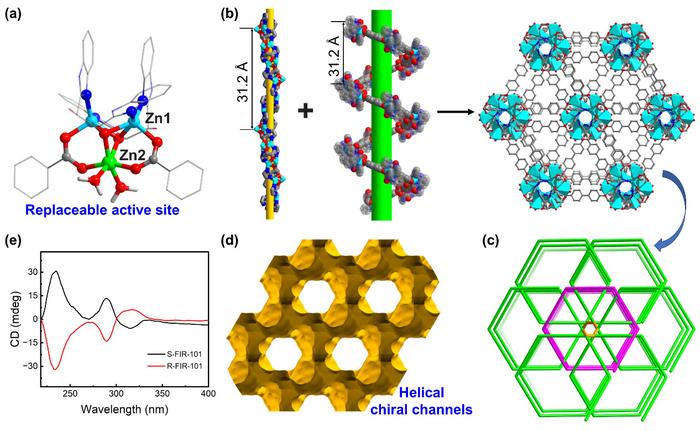
Researchers at the Fujian Institute of Research on the Structure of Matter, affiliated with the Chinese Academy of Sciences, have recently unveiled an impressive advancement in the world of materials science through the development of chiral metal-organic frameworks (CMOFs). This breakthrough represents a significant step forward, merging ultrahigh surface area, remarkable chemical stability, and cost-effective synthesis for practical applications, especially in asymmetric catalysis. The implications of this research stretch far and wide, promising a new horizon for various fields including pharmaceuticals and fine chemicals.
Employing a novel mixed-ligand strategy, the research team designed these innovative CMOFs by synergistically blending inexpensive chiral azoles with achiral carboxylic acids. This method led to the formation of a series of frameworks designated from FIR-101 to FIR-106, each characterized by unique multilevel chirality. The frameworks exhibit an unprecedented ultra-tunable structure that can accommodate a diverse range of ligands and metal ions, revealing their versatility across numerous applications. S-FIR-106, one of their most notable creations in this series, has achieved a record surface area of 3040 m²/g, positioning it as one of the most porous chiral MOFs identified in literature to date.
Beyond their impressive structural properties, these chiral frameworks demonstrated outstanding stability across a spectrum of solvents, pH levels ranging from 2 to 12, as well as under extreme thermal conditions. This behavior strongly distinguishes them from previously reported chiral MOFs, showcasing their ability to maintain crystallinity and structural integrity following rigorous testing. These traits ensure the frameworks are robust and suitable for extended-term applications, which is pivotal in industrial settings where durability is essential.
An interesting aspect of the research is the potential of these CMOFs to act as heterogeneous catalysts for asymmetric transformations. One striking example includes the performance of S-FIR-101 in catalyzing the Oxa-Diels-Alder reaction, a notable reaction in organic synthesis. The framework displayed remarkable performance with high yields and significant enantioselectivity, highlighting its efficacy in asymmetric catalysis. The research team further enhanced catalytic performance by precisely tuning the metal centers within the framework, achieving an impressive enantiomeric excess of up to 98% in one instance.
The implications of synthesizing these CMOFs are profound, primarily due to the method’s ability to reduce the cost associated with producing high-performance chiral catalysts. Additionally, the synthesis process is designed for scalability, evidenced by the successful production of over 100 grams of S-FIR-101 in a single batch. This feature is critical for the anticipated industrial applications, as it demonstrates practicality in scaling up production to meet market demand.
Notably, the methodological advancements introduced by the researchers embody a shift towards a more sustainable synthesis of chiral materials. The utilization of cost-effective and readily available ligands not only minimizes production costs but also aligns with the growing trend of sustainability in materials science. By employing a straightforward yet efficient approach, the team sets a precedent in breaking down barriers associated with the high cost of chiral catalysts, encouraging broader accessibility to high-performance materials in various sectors.
Furthermore, the research paves the way for extensive investigations into the versatility of these frameworks concerning various reactions beyond mere catalysis. The combination of multilevel chirality and tunable frameworks opens up avenues for exploring other applications such as gas storage, separation processes, and even drug delivery systems, making CMOFs a focal point in ongoing material science research.
In conclusion, this research conducted by the State Key Laboratory of Structural Chemistry underscores the innovative capabilities of Chinese researchers in the field of materials science. Supported by the National Key R&D Program of China and the National Natural Science Foundation of China, their work is a testament to the collaborative efforts shaping the future of chiral materials. The prospects for these frameworks are overwhelmingly promising, potentially transforming practices in asymmetric catalysis and other areas while drawing on the elements of sustainability and cost-effectiveness essential for modern research.
The insights provided by this research not only advance the scientific community’s understanding of chiral frameworks but also serve as a crucial springboard for future innovations. As materials scientists continue to push the boundaries of what is possible with CMOFs, the implications for practical applications in industries such as pharmaceuticals and fine chemicals cannot be overstated. In an age where efficiency and sustainability are paramount, these groundbreaking findings are indeed a significant leap toward achieving long-term goals in materials science.
Subject of Research: Chiral metal-organic frameworks (CMOFs) for asymmetric catalysis
Article Title: Significant Breakthrough in Chiral Metal-Organic Frameworks
News Publication Date: [Publication date missing]
Web References: [Web references missing]
References: [References missing]
Image Credits: ©Science China Press
Keywords
Chiral metal-organic frameworks, asymmetric catalysis, materials science, ultrahigh surface area, multilevel chirality, sustainable synthesis.
Tags: advancements in materials science researchasymmetric catalysis applicationschiral metal-organic frameworkscost-effective synthesis of CMOFsexceptional chemical stability of materialsinnovative materials for fine chemicalsmixed-ligand strategy in materials sciencemultilevel chirality in frameworkspharmaceutical applications of MOFsporous chiral metal-organic frameworksultrahigh surface area materialsunique ligand accommodation in CMOFs





